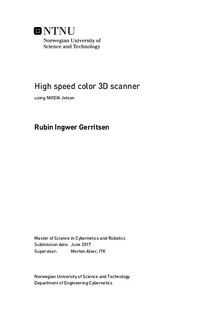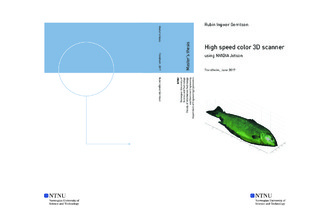| dc.description.abstract | Automatic quality grading of food products is often performed by machine vision systems. The maximum performance of such a system is determined by the amount and quality of the data used. A 3D color scanner is able to capture more data than conventional machine vision systems; in addition to color and shape, it also extracts height profiles. However, 3D line scanners available on the market today are expensive because they use advanced customized components. Therefore, SINTEF Ocean has developed a 3D line scanner for only a third of the price by using standardized off-the-shelf components. This price reduction makes the solution applicable to a wider range of problems.
This thesis presents a distributed 3D line scanner using a GPU enabled NVIDIA Jetson TK1 and a NVIDIA Jetson TX1, which reduces the hardware and deployment cost even more compared to SINTEF's solution. The developed scanner is able to operate in multiple modes and is highly configurable over TCP/IP. Each of the modes extracts different object parameters such as height, scatter, and color. It presents how the scanner is benchmarked to find its maximum performance, and how the scan quality is examined by performing repeatability tests and by performing scans of salmon.
The accuracy of the scanner is determined by the scan rate and camera image size. Increasing the image size increases the cross section accuracy but decreases the scan rate. When both color and height is extracted from an image with size 1280x192 pixels, it was found that the Jetson TK1 and Jetson TX1 were able to obtain a scan rate of respectively 220 and 620 frames per second. This is much slower than the image processing module, which is able to obtain a theoretical maximum frame rate of 4600 and 7300 frames per second. The Jetson TK1 is limited by its slow memory transfer speed, while the Jetson TX1 is limited by the maximum frame rate of the camera.
The developed scanner utilizing the Jetson TX1 has the same performance as the previous system developed by SINTEF. The image processing implementation is portable to other GPUs and much faster than the camera can handle. Consequently, there is a large potential performance increase by using another camera solution. Therefore, this master thesis is a valuable contribution to further development of high speed, low cost, 3D line scanners. | |

